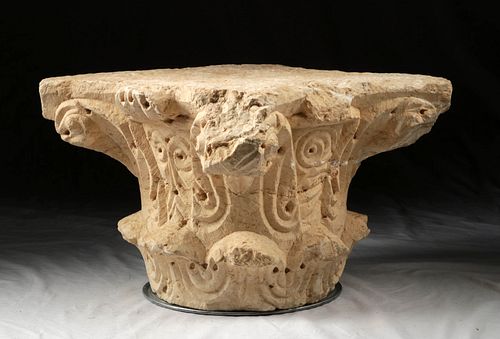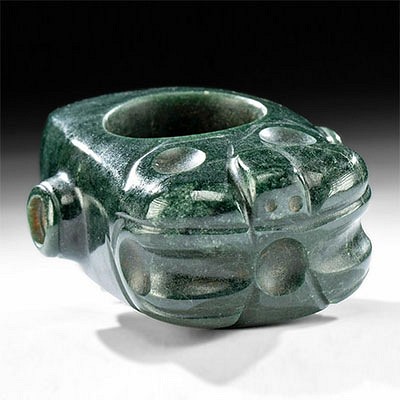Beautiful Roman Marble Capital Architectural Feature
Lot 36a
About Seller
Artemis Fine Arts
686 S Taylor Ave, Ste 106
Louisville, CO 80027
United States
Selling antiquities, ancient and ethnographic art online since 1993, Artemis Gallery specializes in Classical Antiquities (Egyptian, Greek, Roman, Near Eastern), Asian, Pre-Columbian, African / Tribal / Oceanographic art. Our extensive inventory includes pottery, stone, metal, wood, glass and textil...Read more
Categories
Estimate:
$6,000 - $8,000
Absentee vs Live bid
Two ways to bid:
- Leave a max absentee bid and the platform will bid on your behalf up to your maximum bid during the live auction.
- Bid live during the auction and your bids will be submitted real-time to the auctioneer.
Bid Increments
| Price | Bid Increment |
|---|---|
| $0 | $25 |
| $300 | $50 |
| $1,000 | $100 |
| $2,000 | $250 |
| $5,000 | $500 |
| $10,000 | $1,000 |
| $20,000 | $2,500 |
| $50,000 | $5,000 |
| $100,000 | $10,000 |
| $200,000 | $20,000 |
About Auction
By Artemis Fine Arts
Sep 10, 2020
Set Reminder
2020-09-10 10:00:00
2020-09-10 10:00:00
America/New_York
Bidsquare
Bidsquare : Antiquities | Asian | Ethnographic Art
https://www.bidsquare.com/auctions/artemis-gallery/antiquities-asian-ethnographic-art-5546
Featuring classical antiquities, ancient and ethnographic art from cultures encompassing the globe. Egyptian, Greek, Roman, Etruscan, Near Eastern, Asian, Pre-Columbian, Native American, African / Tribal, Oceanic, Spanish Colonial, Russian, Fossils, Fine Art, more! Artemis Fine Arts info@artemisfinearts.com
Featuring classical antiquities, ancient and ethnographic art from cultures encompassing the globe. Egyptian, Greek, Roman, Etruscan, Near Eastern, Asian, Pre-Columbian, Native American, African / Tribal, Oceanic, Spanish Colonial, Russian, Fossils, Fine Art, more! Artemis Fine Arts info@artemisfinearts.com
- Lot Description
Roman, later Imperial period, ca. 3rd to 5th century CE. A beautifully-preserved example of a marble column capital, with a drilled decorative motif of abstract waves, floral motifs, and lion paws. The corners project outward with large spirals, while the base is ringed with downturned acanthus leaves. The base has a round, drilled cylinder used to attach the capital to a column. Delicate swirls and folds speak to the skill of the artisan who made the piece, which would have adorned a luxurious building of Classical style. The base is drilled into so that it could be attached to a column; the top is similarly drilled into in two places. Size: 23.8" L x 19.7" W x 12.7" H (60.5 cm x 50 cm x 32.3 cm)
The drilled motifs are the clue to the age of this piece. From the 3rd century CE onward, Roman sculptors commonly began to use running drills for decorative effects. Holding a wooden support in one hand to guide the drill bit, the sculptor would drill into the surface at a 30-45 degree angle, repeatedly lifting and moving the drill to create a series of holes at a shallow angle to the surface of the stone, creating the appearance of a channel, as you can see here with the wavy effect used to create the impression of folded leaves. This is not only a beautiful piece, but also demonstrates the skill and tools of Roman artists.
A Roman marble column capital sold at Christie's for $6250 in 2008: https://www.christies.com/lotfinder/Lot/a-roman-marble-column-capital-circa-2nd-3rd-5157998-details.aspx
Provenance: private East Coast, USA collection; ex-William Froelich collection, New York, USA, acquired in the 1970s
All items legal to buy/sell under U.S. Statute covering cultural patrimony Code 2600, CHAPTER 14, and are guaranteed to be as described or your money back.
A Certificate of Authenticity will accompany all winning bids.
We ship worldwide and handle all shipping in-house for your convenience.
#146307Extensive weathering on surface as shown, including shallow fissures and losses to peripheries, especially to the projecting corners on two sides. Deposits on surface.Condition
- Shipping Info
-
All shipping is handled in-house for your convenience. Your invoice from Artemis Gallery will include shipping calculation instructions. If in doubt, please inquire BEFORE bidding for estimated shipping costs for individual items.
-
- Buyer's Premium



 EUR
EUR CAD
CAD AUD
AUD GBP
GBP MXN
MXN HKD
HKD CNY
CNY MYR
MYR SEK
SEK SGD
SGD CHF
CHF THB
THB














